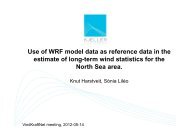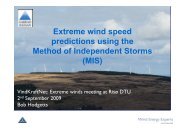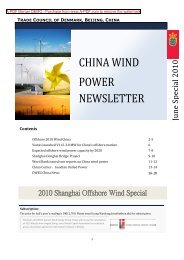Introduction Representation in WAsP
Introduction Representation in WAsP
Introduction Representation in WAsP
You also want an ePaper? Increase the reach of your titles
YUMPU automatically turns print PDFs into web optimized ePapers that Google loves.
ConclusionsHigh displacement and slow decay may allow for a ”hedg<strong>in</strong>g of bets”:Mast displacement height is less sensitive to errors on the distance from the trees.”Differential error” between <strong>in</strong>itiation and target mast is reduced on average.This analysis benefits from prior knowledge of the w<strong>in</strong>d regime at the target site.Without such prior knowledge, it is not quite as easy to discrim<strong>in</strong>ate between ”good”and ”bad” masts, and thus to determ<strong>in</strong>e when we should buy the costly ”high-d,low-s <strong>in</strong>surance”Can the conclusions from this study be appliedto other sites?to other ways of calculat<strong>in</strong>g the displacement height?Future workF<strong>in</strong>ish calculations us<strong>in</strong>g Raupach and Choudhury canopy modelsPopulate with a few more sites – good and bad!Further explore (d/h, z 0 , s) parameter spaces = 1:100, 1:200…. 1:∞ as a tactical <strong>in</strong>surance device?Extreme hedg<strong>in</strong>g of bets for bad mastsCalculate a separate displacement height for each sector, apply sector-wiseWhen calculat<strong>in</strong>g d, <strong>in</strong>clude trees located immediately downw<strong>in</strong>dw<strong>in</strong>d
















